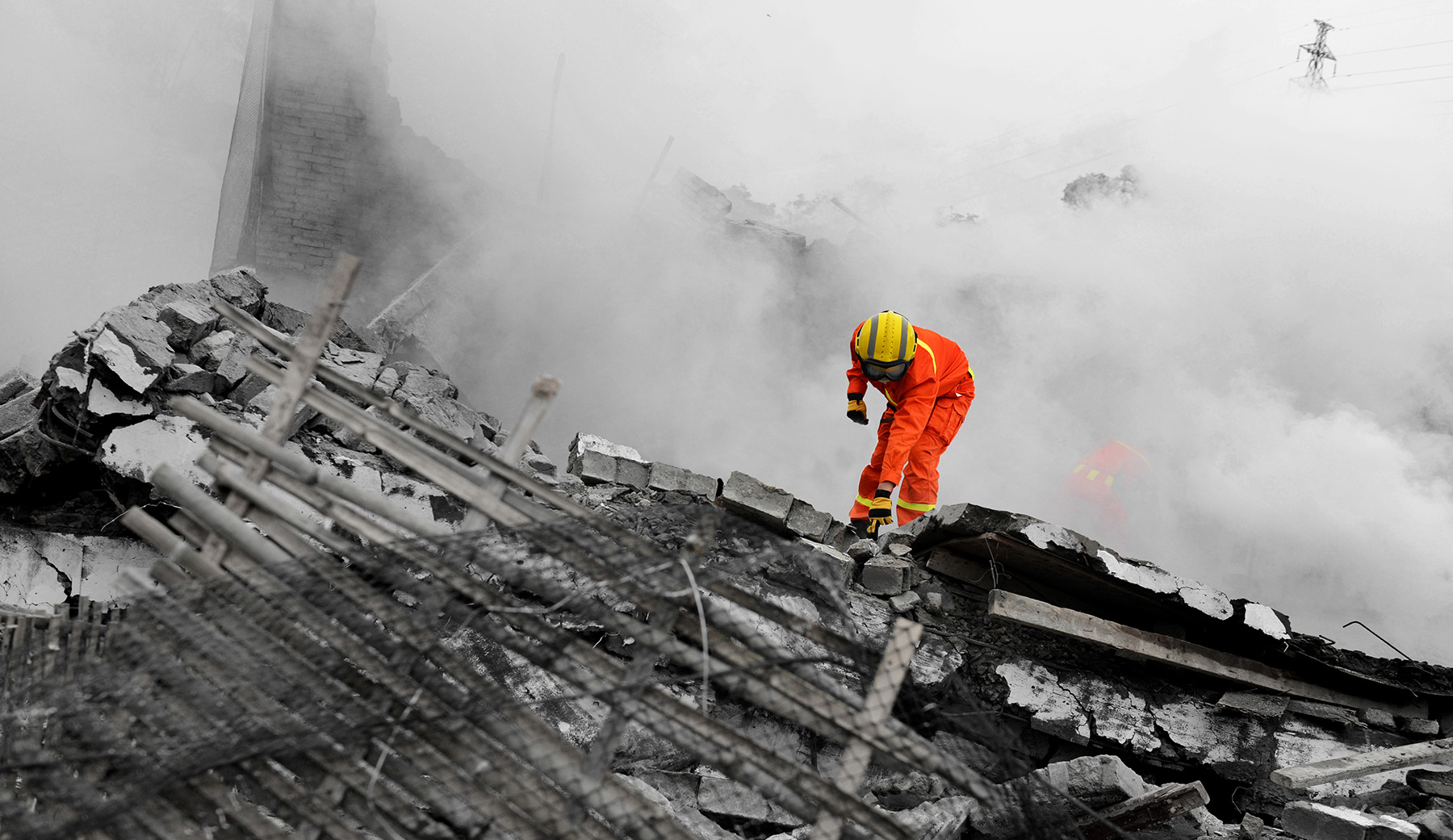
By Tom Caldwell, P.E., M.ASCE, and Lt. Col. Mike Riccitiello, P.E., PMP
Coping with natural disasters in a fact of life. Civil engineers are on the ground in the aftermath as first responders, investigators, and rebuilders. But how do they stay safe in disaster zones and still get their jobs done?
Engineers work hard to make natural disasters more survivable by designing infrastructure that can withstand disaster loads, or at least fail gradually. This critical design work before disasters saves many lives. But engineers are also needed after disasters for search and rescue, emergency safety assessments, failure investigations, and repair and reconstruction.
Climate data strongly suggest these natural disasters are becoming more frequent and severe, while population density continues to rise in high-risk regions, such as in coastal and forest-fringe areas. This pattern of increasing risk creates a greater need for civil engineers to be on the ground after disasters, often in dangerous places far different than their usual offices or construction sites. Yet few are trained for these environments.
Disaster landscape
Natural disasters — tornados, hurricanes, earthquakes, wildfires, etc. — produce a wide range of damage to the built environment. High winds can tear open and destabilize buildings. Rising waters from flooding or storm surge can create swift-water conditions that can cause scour, undermine foundations, and damage roadways or bridges. Earthquakes can cause widespread structural damage and ongoing risks of aftershocks. The aftermath of any disaster may include chemical spills, fires, and biological hazards. Law enforcement and medical care may be delayed or unavailable if access routes are blocked.
The common element in all disasters is uncertainty. We take safety factors and structural stability for granted. We expect dangerous chemicals and high-voltage wires to be safely contained, and law and order to prevail. In a disaster zone, none of these is certain.
Disaster timeline
Civil engineers’ traditional engineering role is “left of boom,” that is, pre-disaster. We design infrastructure that is cost-effective yet also robust enough to endure the rare but foreseeable overloads that natural disasters might impose.
Our priority is protecting people, often by designing structures to absorb substantial damage and fail slowly enough to allow people to escape. An example is seismic design: Building frames are designed to bend and deform during an earthquake without breaking apart and collapsing.
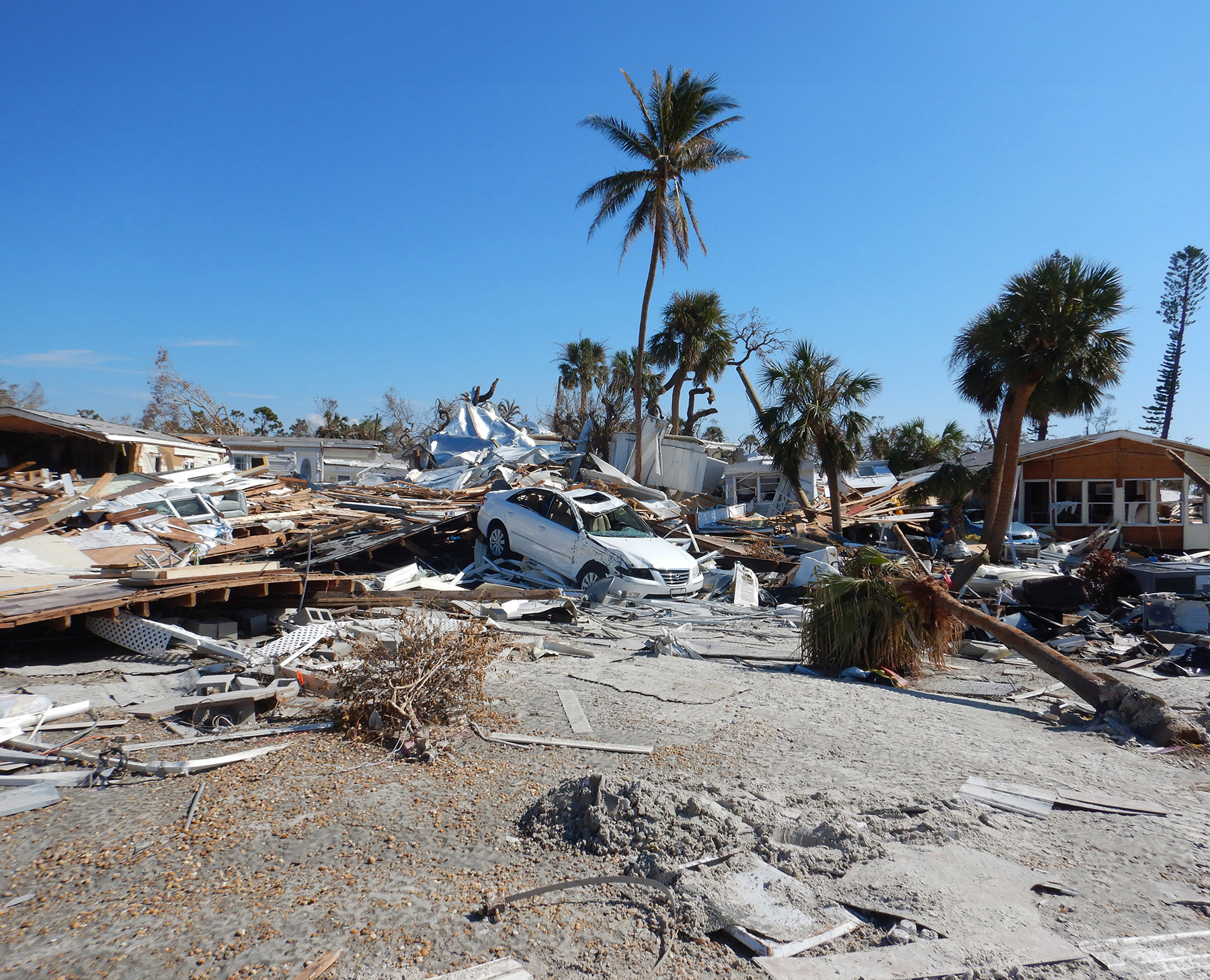
But today, engineers are increasingly called to serve “right of boom,” or post-disaster. The graphic shows the typical sequence of recovery tasks after disaster strikes. This is on-the-ground fieldwork in the disaster zone.
Local authorities often have to evacuate large areas ahead of hurricanes, floods, and wildfires. Afterward, citizens and businesses are eager to return. The Safety Assessment Program — administered by the California Office of Emergency Services — trains civil engineers to work in tandem with local officials at disaster-damaged communities. Their job is to quickly identify structures that are safe to occupy and tag those that require further study or are clearly unsafe. This work can help repopulate moderately damaged areas and is a vital step in social recovery.
Civil engineers also perform a wide range of post-disaster investigations. Several professional societies — ASCE and the American Concrete Institute, for example — field engineering teams to assess the resiliency of the built environment. These investigators look for ways to improve future designs. Other engineers perform field investigations for insurance claims and litigation or conduct the detailed post-disaster condition surveys needed for repair and reconstruction.
Civil engineers are needed on the ground for every step of disaster recovery. How are they trained for this special environment?
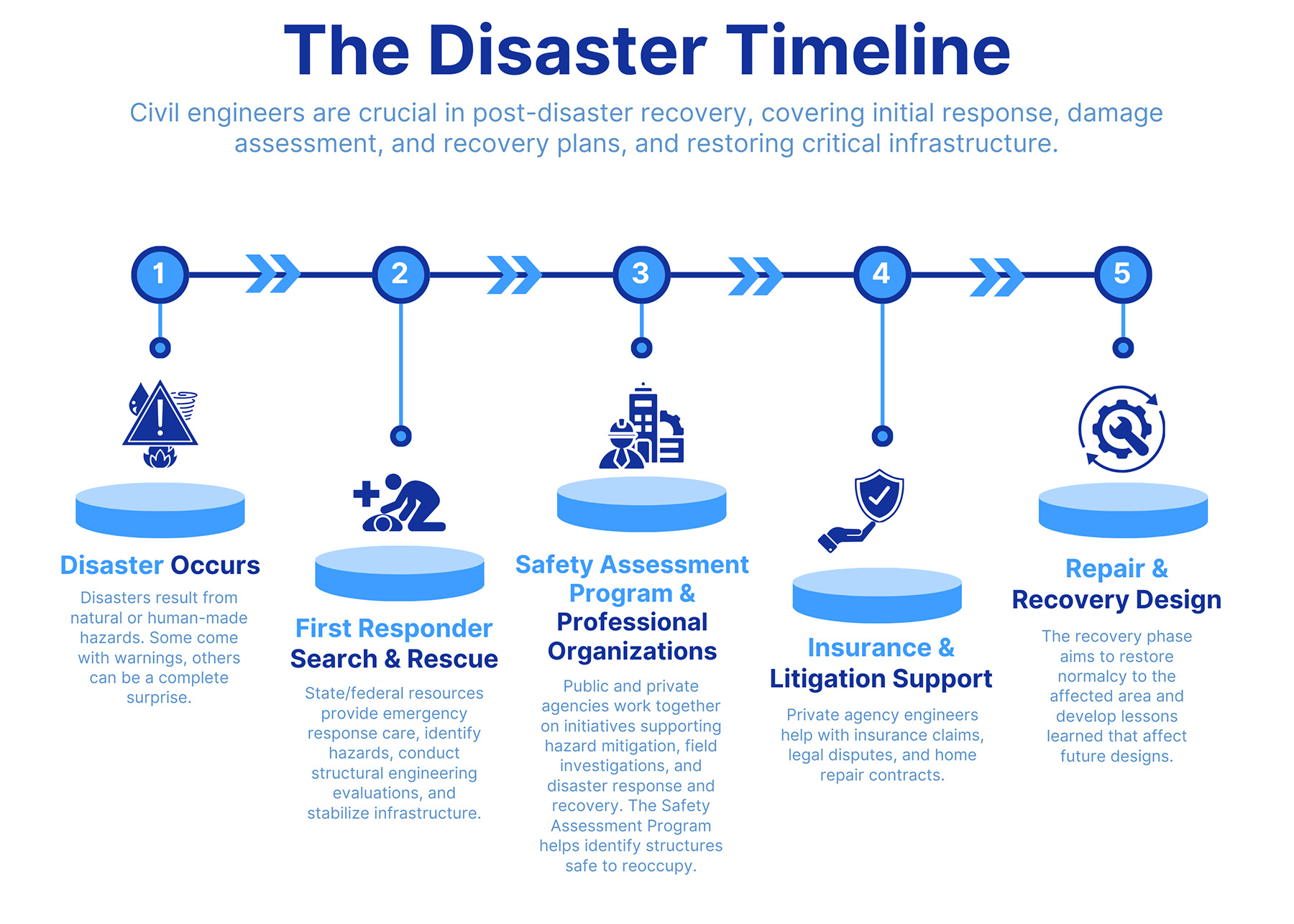
Disaster response preparation
Working safely in a disaster zone calls for a unique combination of training, equipment, and tradecraft.
Nationally, about 240 civil engineers are qualified to serve as first responders with federal and state urban search and rescue teams. These engineers undergo extensive and recurring training in disaster operations and damage assessment. Their central role is to reduce risks for fellow first responders. Specialized skills include emergency shoring, stability monitoring, and emergency ad hoc repairing that reduces public risk. Their most important skill is to balance risk against reward, making professional, reasoned comparisons between risks and benefits.
SAP-certified engineers are second responders and work with local officials to assess damage in disaster zones. Safety training for these engineers covers using personal protection gear, working in pairs, and avoiding obviously unstable structures. Most importantly, SAP engineers are taught to stay alert to unforeseen hazards in disaster zones. Roughly 4,000 engineers across the United States are trained for this type of work.
For other engineers working in disaster zones, training is often limited to their firm’s in-house safety program and perhaps a short Occupational Safety and Health Administration course or two.
This article helps build upon these basic safety courses. Please keep in mind that the advice we offer here is not exhaustive. First and second responder engineers should always review their official training and protocols prior to visiting a disaster zone.
Disaster risk zones
Natural disasters sometimes result in extremely dangerous working conditions. Only the most critical needs justify working in these areas. These include search and rescue, repairing imminent threats to public safety, and body recovery. The federal and state teams that do this work include civil engineers.
Post-disaster access to high-risk areas is controlled by public authorities so that critical needs can be prioritized. A recent example is the wind-driven firestorm that devastated Lahaina on the island of Maui in Hawaii last August. The fire left behind a highly hazardous landscape of partially collapsed and unstable structures. Local and state authorities limited access to Lahaina to highly qualified fire, recovery, and search and rescue teams.
Another recent example is Hurricane Ian in 2022, which, as a Category 5 storm, devastated parts of western Cuba, southwest Florida, and the Carolinas, severely damaging life and property. Additionally, the July 2023 flooding in Vermont created multiple threats to public safety, including damaged bridges and landslides. These were critical, high-risk situations that required engineers to work in high-risk zones.
But most engineering work in disaster zones occurs in more moderate conditions. These could be low-rise buildings after a fire or flood, or damaged multistory structures that are still substantially structurally sound. These are typical conditions faced by most forensic, SAP, and reconstruction engineers.
Disaster tradecraft: The how-tos
The following sections outline the everyday basics of working safely within a disaster zone.
Be prepared. Well before any disaster strikes, make an equipment checklist and pack a “go” bag with personal protective equipment, field gear, first-aid supplies, communication devices, and food and water.
Before arriving at a site, review your mission. What is your role? Why are you going into the hazard zone? What do you expect to accomplish there? Be honest and ask yourself: What hazards do I expect to face, and am I prepared for them? Am I authorized to be there? Is it worth the risk?
Create and follow a communication checklist. What are your primary and backup forms of communication? Have you informed the right people about where you are going and when to expect your return? Reception will be spotty or nonexistent in a disaster zone, so before you go, download maps, imagery, news reports, and contact information for critical individuals.
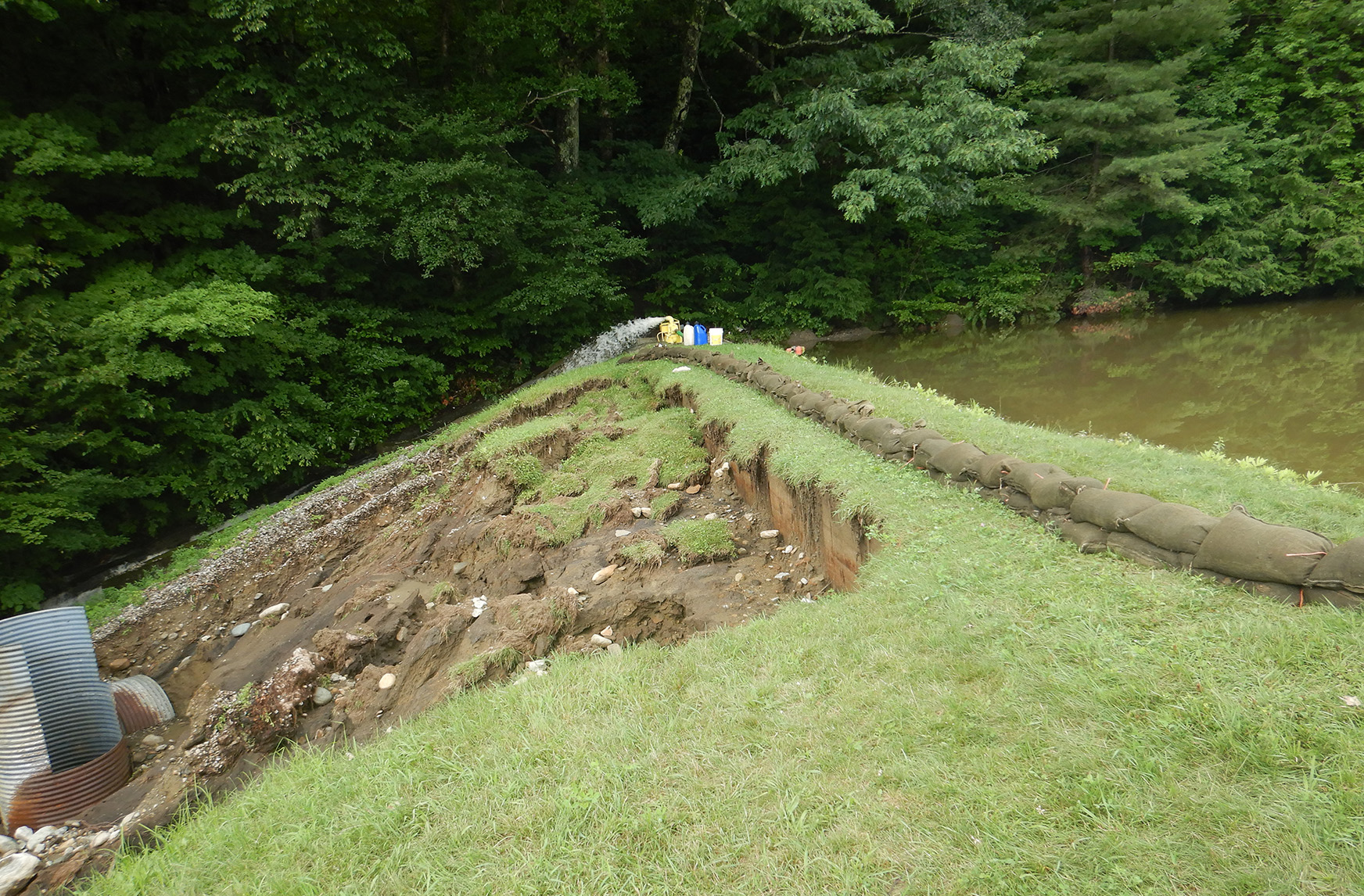
The most important thing to bring is a professional attitude. Leave bravado and ego at home. Constantly balance the risks and rewards and commit to proper protective equipment and protocols. Getting yourself hurt is unprofessional, and your injury will be an unwelcome extra burden to a community already in crisis. Remember the first rule of disasters: Do not make it worse.
Stay alert, stay alive. Situational awareness is critical because nothing is normal at disaster sites, and safety cannot be taken for granted at first glance. Damaged buildings may be only a gust of wind or an aftershock away from collapse. Bridges that appear intact might be undermined by floodwaters and scour. Unexpected dangers can arise. Hurricane Katrina’s storm surge along coastal Louisiana in 2005 flushed alligators out of their home marshes and into residential areas, presenting a unique hazard during initial search and rescue efforts.
Find out which organizations, officials, and recovery teams are on the scene and what operations are already underway. Whenever possible, talk with responders and public authorities. Make sure you have permission to enter the area and that you are not interfering with critical missions that may be more important than your own.
Before venturing into a damaged site, do a “360,” circling the area at a safe distance to learn about the site and identify hazards. In the aftermath of Hurricane Ian, engineers assessed the stability of debris piles as part of search efforts. If available (and allowed by public authorities), use overhead drone imaging, which can be priceless. Such images were key for responders after a major gas explosion in 2019 in downtown Durham, North Carolina, that severely damaged several buildings. Imaging identified which roof diaphragms were destroyed and which were intact — a major factor in the stability of unreinforced masonry walls and the relative safety of each building.
Sketch the site and consider which areas offer relative safety and which are clearly more hazardous. This is a good time to stop, think, and plan for the best way in, as well as how far you will need to go to complete your task. Is the value of accessing this dangerous area worth the risk? True professionals answer this question honestly and are prepared to say no.
When facilities are damaged, any changes in conditions deserve attention. Stay alert to odd noises or odors and to what other people or equipment are doing on-site. Take note of the weather, especially of rising or shifting wind, heavy rain, or thunder. The severe flooding in Vermont mentioned above overtopped and heavily damaged an earthen dam on the Upper Chester Reservoir, upstream of a populated area. The dam held, but another storm system moved in before the reservoir level could be lowered. The heightened threat of dam failure prompted evacuations and emergency repairs.
Beware of complacency. After a few hours or days at a disaster site, conditions that seemed lethal at first often become normalized, especially if nothing unexpected happens. Remember that damaged structures never become safer with time.
Work disaster sites in pairs: One person doing the work and the other focusing solely on safety and situational awareness. Always remain willing and able to retreat to a safe area and reassess.
Finally, do not be influenced by others on-site who show less respect for dangerous conditions. Through inexperience or bravado, some workers take unnecessary chances at disaster zones. Set your own example. Professionals strive for safety.
Take every opportunity to reduce risks. Specialized tools, equipment, and protocols can make disaster work far safer. Simple equipment provides standoff distance from hazards, which is a sure way to reduce risk. A pair of binoculars or a more elaborate camera — transit, total station, or telephoto — can help you gather information from a safe distance. As mentioned earlier, drones provide an even better option to gain visual access to highly hazardous areas. For the 2021 partial collapse of Champlain Towers in Surfside, Florida, first responders employed all these options to maintain the necessary standoff distance for the 13-story portion of the building left standing.
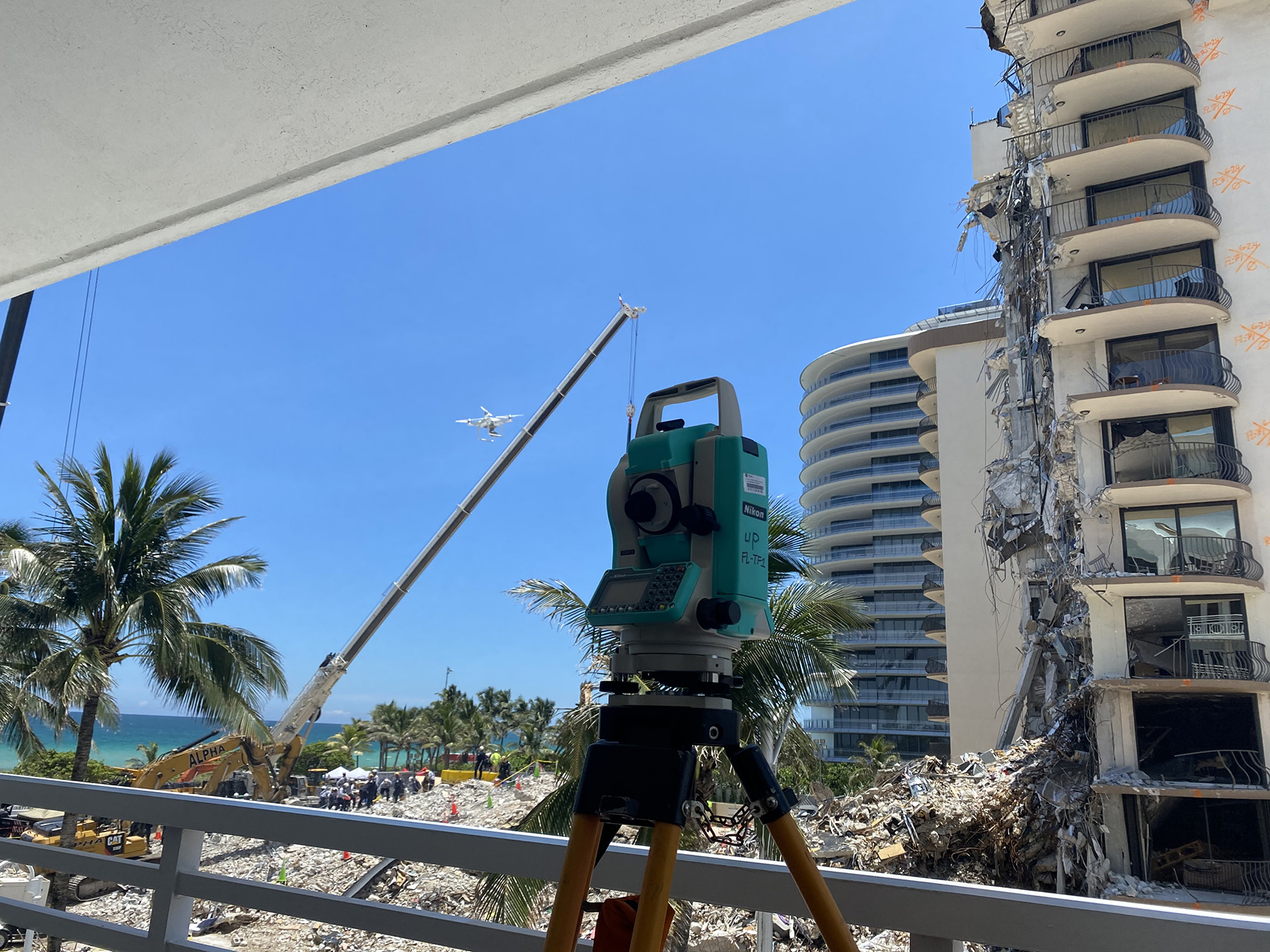
When engineers must work in close proximity to hazards, a protocol of planned site entries can enhance safety. Make gradual entries into the most highly damaged areas, stopping frequently to examine your surroundings, overhead conditions, and next steps. Do not go farther than you need to and always keep your escape route or exit path in mind.
After a partial building collapse in the town of West, Texas, just north of Waco, investigators mapped all intact exits first, then they began a series of planned entries, each reaching a bit deeper into the building. After each entry the team debriefed, updated the site sketch and hazard list, and planned the next entry.
In the aftermath of an earthquake in Sparta, North Carolina, in 2020, engineers and county officials were dispatched to conduct structural damage assessments. Each engineer was paired with a county official, and a plan was discussed prior to entering every structure. The threat of aftershocks called for clear communication and precise planning.
In summary, use equipment that allows standoff distance whenever possible. And when you have to approach hazards more closely, think it through and make a plan.
Debrief, decontaminate, and depart from the disaster zone. Before leaving a disaster site, find a relatively safe place nearby to review what you have seen. As with any fieldwork, this is the time to recheck your task list, confirm you are done, and make sure no equipment is left behind.
But it is also the time to debrief your team and think about others on-site and those who may come later. Let other people on-site know you are leaving and tell them about the site hazards you encountered, such as loose overhead debris, unstable footing, or open pits. Flag dangerous areas with survey ribbon to warn others who may come after you.
As engineers, we are obligated to report serious hazards and threats to public safety, such as gas leaks, unsafe bridges, or unstable tall buildings. Be prepared to stay on-site until authorities arrive and assist them as needed to secure the situation.
Departure is also the time to start decontamination. Disaster sites are often polluted with dust, mold, decayed matter, and occasionally biohazards and toxins. Before leaving the site, stow boots, gloves, overalls, and contaminated tools in trash bags. Once home, rinse these items off outside, take a shower, and launder field items separately from other clothes. Dispose of items that cannot be properly decontaminated.
Finally, check in with your team. Ensure everyone is home safe and feeling well. Check back in a few days. Remember that disaster work is always stressful and can be overwhelming. Be there for each other even after the job is done.
Basic preparation, common-sense tradecraft, and alertness are crucial to staying alive in a disaster zone.
Tom Caldwell, P.E., M.ASCE, is a senior partner, and Lt. Col. Mike Riccitiello, P.E., PMP, is the president of Atlas Engineering in Raleigh, North Carolina. The two serve as engineer first responders with state and federal heavy rescue teams.
This article first appeared in the July/August 2024 issue of Civil Engineering as “Disaster Zone Safety.”




